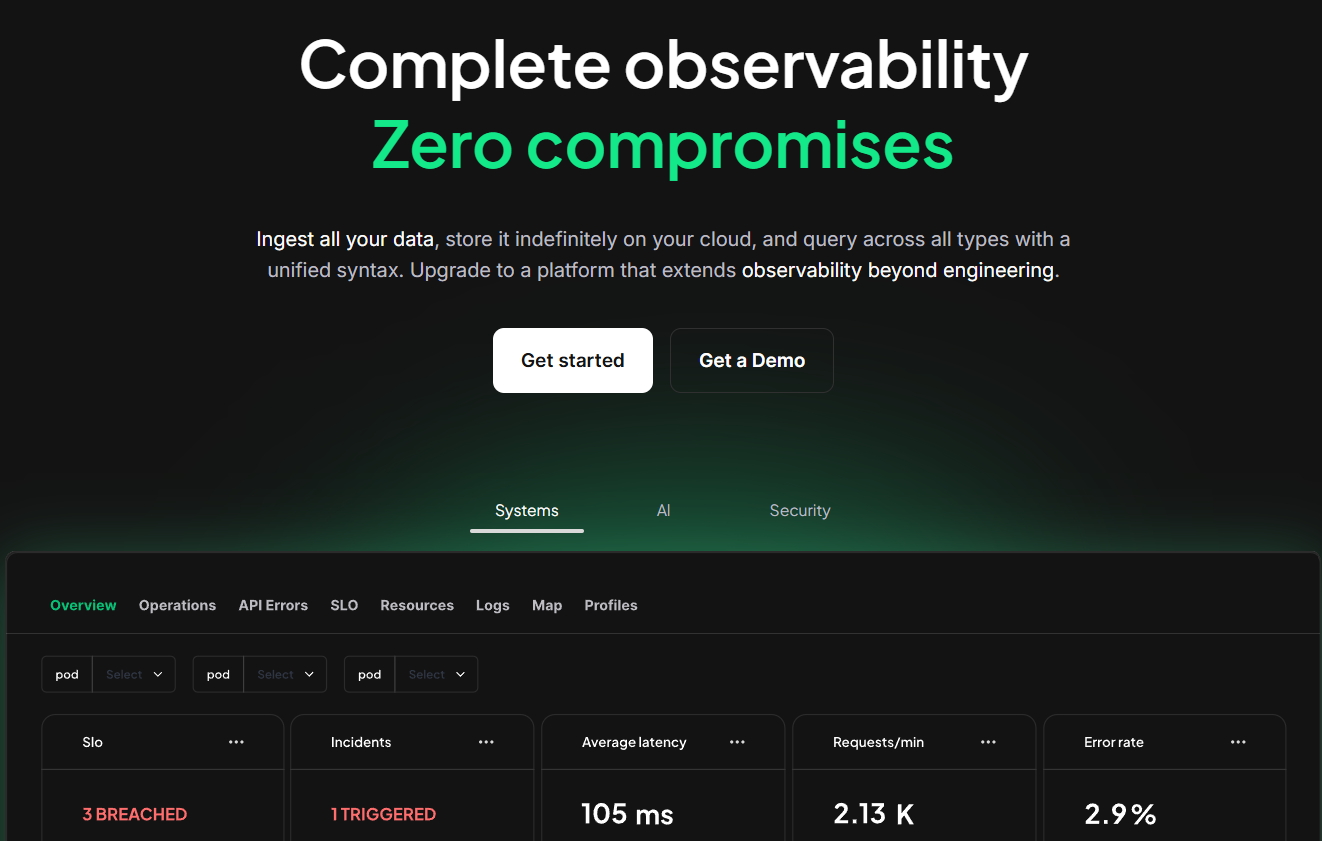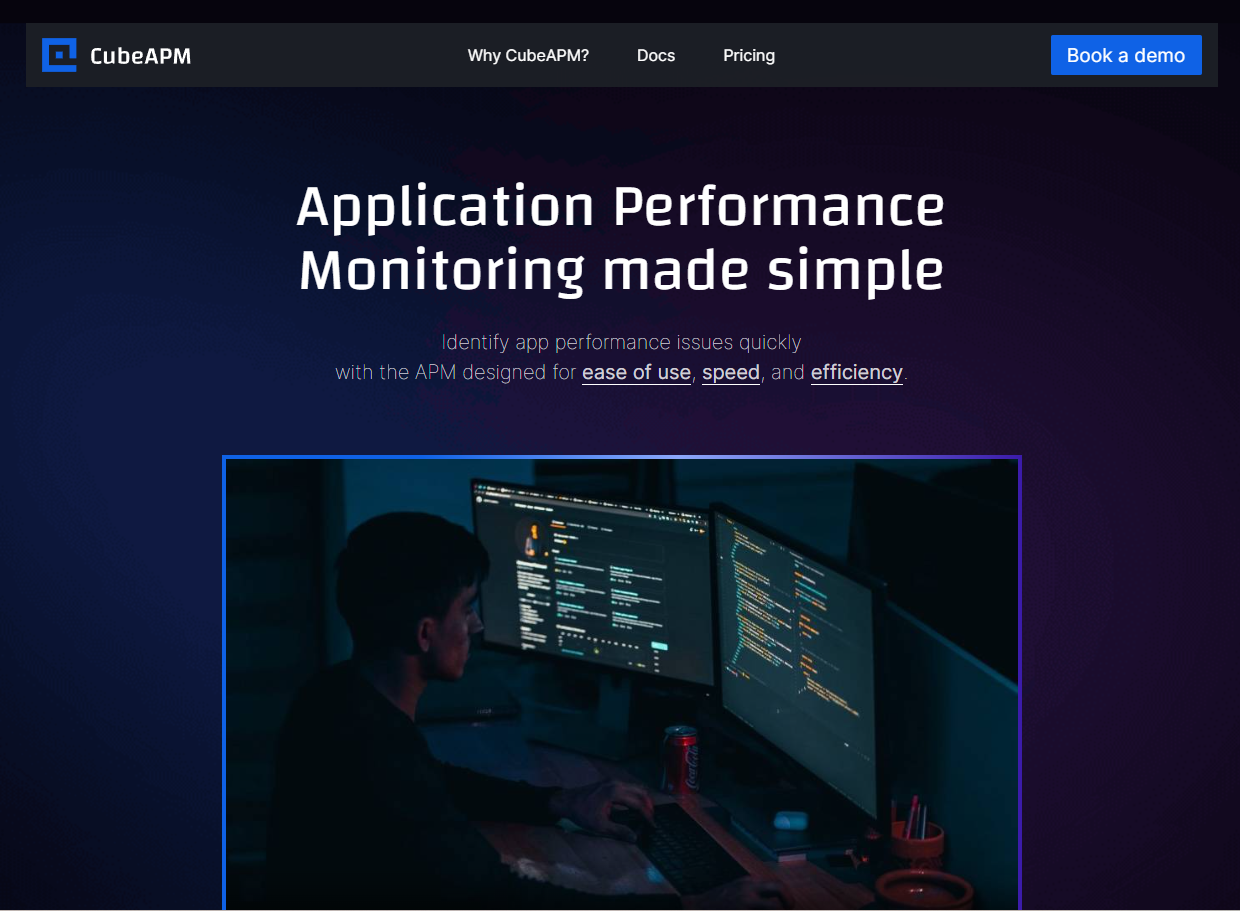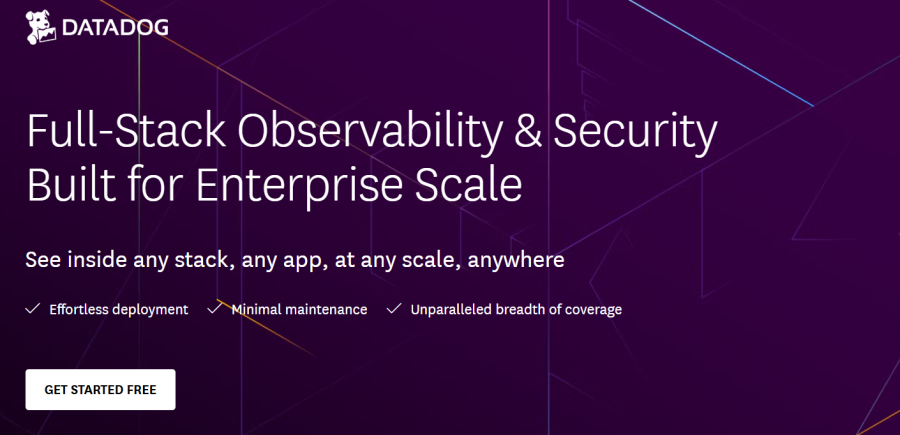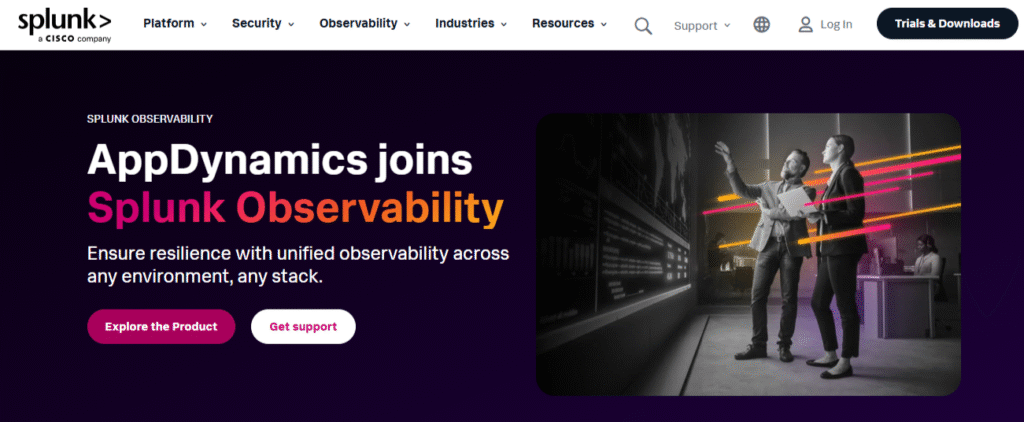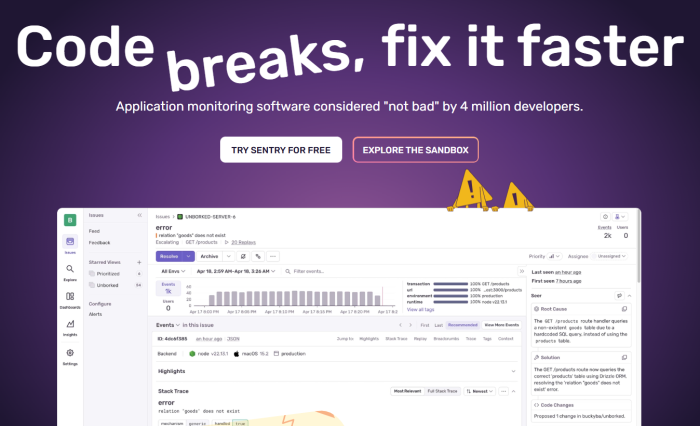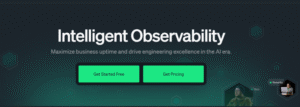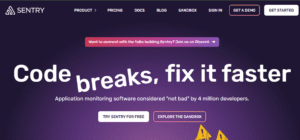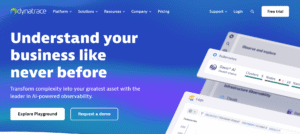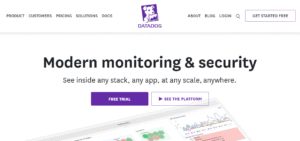Table of content
ToggleCoralogix, known for its log-centric architecture and Streama™-based log routing, offers strong ingestion control and native OTEL support, making it a popular choice for log-heavy workloads. However, organizations seek unified visibility across the stack, and many are outgrowing Coralogix due to its limited full-stack coverage, opaque pricing, and data residency concerns. With the APM market forecasted to grow to USD 46.89 billion by 2030, enterprises are considering solutions that offer unified MELT stacks (Metrics, Events, Logs, Traces) to eliminate fragmentation and improve incident resolution. In this context, platforms like Coralogix, while powerful for logs, fall short on broader observability needs such as RUM, infra metrics, and synthetics.
One area of concern is Coralogix’s archive storage design, where telemetry data, after being ingested, is stored in the customer’s cloud to reduce long-term costs. While this seems cost-efficient, it introduces data egress fees and violates data localization policies for regulated industries. As the data first flows through Coralogix servers, it fails to meet strict compliance needs like DPDP, HIPAA, and GDPR, which require full control over data residency. Teams are also incurring double costs—once during egress from Coralogix and again during re-storage in their cloud buckets.
CubeAPM is a full-stack, OpenTelemetry-native observability platform designed for teams seeking cost transparency, data residency control, and fast, developer-friendly workflows. It offers built-in support for APM, logs, infra, RUM, synthetics, and error tracking, deployable in under an hour. With smart sampling, no per-user fees, and pricing as low as $0.15/GB, CubeAPM delivers up to 80% cost savings over log-centric platforms like Coralogix. It also supports self-hosting for regulated industries and provides real-time Slack support, making it ideal for teams moving away from fragmented or compliance-limited observability stacks.
In this article, we’ll break down the top Coralogix alternatives in 2025 across categories like feature depth, deployment flexibility, pricing transparency, OTEL compatibility, and support experience, starting with CubeAPM.
Top 7 Coralogix Alternatives
- CubeAPM
- Grafana
- DataDog
- DynaTrace
- Splunk AppDynamics
- Sentry
- New Relic
Why Look for Coralogix Alternatives?
Although Coralogix delivers strong flexibility for log management, its growing adoption has also surfaced several critical drawbacks that engineering and platform teams increasingly report:
1. Log-Centric, Not Full-Stack
Coralogix is primarily a log-first platform, with support for metrics and traces added later. It lacks native RUM, synthetic monitoring, and infrastructure visibility, forcing teams to integrate other tools like Grafana, Prometheus, or Pingdom for full MELT coverage.
2. Inconsistent Data Residency Compliance
Coralogix archives telemetry data in the customer’s cloud (e.g., AWS S3), but data first passes through its cloud pipeline for processing. This setup may conflict with data localization laws like GDPR or India’s DPDP, which require sensitive data to stay within organizational or geographic boundaries. This intermediate processing step raises compliance concerns for industries like healthcare or finance, where data sovereignty is critical.
3. Egress Cost & Double Billing
Although archive storage is offloaded to the customer’s cloud, teams pay egress fees when data exits Coralogix, in addition to paying again for their cloud storage. This undermines the cost advantage promoted by their Streama architecture.
Understanding Egress and Cloud Storage Costs
A an example is a a company ingesting 10 TB (10,000 GB) monthly into Coralogix: 70% logs (7,000 GB × $0.52/GB = $3,640), 20% traces (2,000 GB × $0.44/GB = $880), 10% metrics (1,000 GB × $0.05/GB = $50), totaling $4,570/month for ingestion. Archived to AWS S3, it’s compressed to ~2,033 GB, costing ~$46.77/month ($0.023/GB). Querying 10% (203 GB) monthly incurs $18.27 egress fees (203 GB × $0.09/GB). Total: $4,570 + $46.77 + $18.27 = ~$4,635/month. Without queries, it’s ~$4,617/month, but queries add costs, making budgeting tricky.
4. No Native Smart Sampling
Coralogix does not support tail-based or contextual trace sampling. This leads to high data ingestion volumes and missed high-value traces unless manually tuned, raising ingestion and retention costs. Alternatives like CubeAPM’s Smart Sampling use deep contextual analysis to optimize data retention, prioritizing high-value telemetry data (e.g., traces with unusual latency or errors) while discarding low-value “normal” events, achieving a high signal-to-noise ratio. By comparing current samples to historical API latency or performance baselines, it intelligently reduces ingestion volumes, cutting infrastructure costs.
5. Fragmented MELT Implementation
Despite supporting OpenTelemetry, Coralogix’s MELT (Metrics, Events, Logs, Traces) implementation requires manual enrichment and routing to maintain context across traces and logs. This fragmented approach often leads to visibility gaps, as correlating issues across metrics, logs, and errors demands complex configurations. For example, without native tail-based sampling, critical error traces may be missed unless users manually define filters, increasing ingestion costs ($0.52/GB logs, $0.44/GB traces, $0.05/GB metrics) and setup complexity, frustrating teams seeking seamless observability.
6. Custom Setup Complexity
Coralogix’s flexibility comes with a learning curve. Building efficient observability pipelines via Streama, configuring storage tiers, and managing indexing policies requires advanced expertise, which slows down onboarding and incident triage.
Criteria for Suggesting Coralogix Alternatives
When shortlisting the best Coralogix alternatives, we assessed tools across a blend of technical, financial, and operational criteria tailored to the evolving needs of modern DevOps and SRE teams:
1. OpenTelemetry-Native Ingestion
We prioritize platforms with OpenTelemetry (OTEL)-first architectures for seamless data portability and standardized instrumentation, critical for modern DevOps/SRE teams. Tools like CubeAPM, Grafana, and SigNoz natively integrate OTEL, ensuring effortless ingestion of traces, metrics, and logs without proprietary format dependencies. This contrasts with Coralogix, which, despite OTEL support, often requires manual adjustments to align data, risking compatibility issues. OTEL-native platforms streamline integration, reduce vendor lock-in, and future-proof observability pipelines for dynamic, cloud-native environments.
2. Unified MELT Stack
A robust MELT (Metrics, Events, Logs, Traces) stack is essential for holistic observability. We favored tools with native MELT support, plus extras like Real User Monitoring (RUM), synthetics, and error tracking. CubeAPM excels by bundling these natively, ensuring seamless correlation across data types. Coralogix’s MELT implementation, however, requires manual enrichment and routing, leading to fragmented visibility and gaps when correlating issues across metrics, logs, and errors. Tools like Grafana and SigNoz also provide unified MELT, reducing configuration overhead and enhancing issue resolution compared to Coralogix’s disjointed approach.
3. Data Residency Control & Self-Hosting
For companies operating in regulated sectors or multi-region environments, on-prem or private cloud deployment is essential.CubeAPM and Grafana OSS lead with on-prem or private cloud deployment options, ensuring compliance with GDPR, HIPAA, or regional laws. Coralogix’s reliance on customer-managed cloud storage (e.g., AWS S3) for archiving introduces egress complexities, raising compliance concerns due to data movement across regions. Self-hosted solutions like CubeAPM offer full data control, minimizing external dependencies and egress-related risks.
4. Smart Sampling & Cost Efficiency
We emphasized contextual trace sampling (like latency/error-based prioritization) and flat-rate ingestion pricing. Platforms that offer this—such as CubeAPM—enable predictable billing and drastically lower telemetry waste. CubeAPM, for example, charges ~$0.15/GB for ingestion with unlimited users, ensuring 60–80% cost savings.
5. Transparent Pricing Model
SaaS observability tools often hide complexity in modular pricing, retention tiers, or ingestion quotas. CubeAPM keeps it simple with a single rate for all features and unlimited user access, for example, charges ~$0.15/GB for ingestion with unlimited users, ensuring 60–80% cost savings.
Coralogix pricing for a mid sized company
For example, for a mid-sized e-commerce company with 50 hosts, 10 TB (10,000 GB) of monthly data ingestion, and 20 engineers using full access for tracing across payment and inventory services, Coralogix pricing would be calculated based on data type. Assuming a typical data mix of 70% logs (7,000 GB × $0.52/GB = $3,640), 20% traces (2,000 GB × $0.44/GB = $880), and 10% metrics (1,000 GB × $0.05/GB = $50), the total cost comes to $4,570 per month.
Coralogix pricing for a Startup
For a startup with 20 hosts, 4 TB (4,000 GB) of monthly data ingestion, and 10 engineers using full access for tracing across payment and inventory services, Coralogix pricing would reflect the same data type breakdown. With 70% logs (2,800 GB × $0.52/GB = $1,456), 20% traces (800 GB × $0.44/GB = $352), and 10% metrics (400 GB × $0.05/GB = $20), the total cost is $1,828 per month.
CubeAPM Pricing –
The cost is transparent and predictable:
For the mid-sized e-commerce company with 10 TB (10,000 GB) of monthly data ingestion, CubeAPM charges a flat rate of $0.15 per GB, resulting in a total cost of 10,000 GB × $0.15/GB = $1,500 per month.
For the startup with 4 TB (4,000 GB) of monthly data ingestion, the cost is 4,000 GB × $0.15/GB = $600 per month. CubeAPM’s pricing is straightforward, based solely on data ingestion, with no additional charges for hosts or engineers, making it significantly cheaper than Coralogix for both scenarios.
6. Ease of Setup & Migration
Tools must offer quick onboarding, agent compatibility with existing setups (Datadog, New Relic, Elastic), and prebuilt dashboards. CubeAPM’s 1-hour setup and agent compatibility make it migration-friendly.
7. Support Quality & Developer Experience
We preferred platforms that offer real-time Slack or chat-based support, low-latency dashboards, and intuitive UI/UX, helping dev teams resolve incidents fast. CubeAPM offers direct access to engineers in minutes, compared to ticketing queues.
1. Coralogix Overview

Known for:
A log-first observability platform built for teams that require advanced log processing, flexible routing, and cost optimization via stream-based indexing and storage decoupling. Coralogix is widely adopted in environments with heavy log volume, compliance needs, or CI/CD monitoring requirements.
Standout Features:
- Streama™ Architecture:
Decouples log ingestion from indexing, allowing high-throughput processing with customizable retention and routing rules. Reduces indexing costs by letting users choose which logs to index vs. store.
- Customer-Controlled Archival:
Archived telemetry data is pushed to the customer’s cloud (S3/GCS) for long-term retention, eliminating Coralogix storage charges for cold data.
- CI/CD & Security Integrations:
Coralogix integrates with GitHub, Jenkins, CircleCI, and SIEM tools, enabling use cases beyond observability, like auditing, release monitoring, and security visibility.
Key Features:
- Log Ingestion & Parsing:
Real-time structured and unstructured log ingestion with custom parsing, enrichment, and alerting rules.
- Metrics & Tracing Support:
Supports OpenTelemetry and Prometheus for ingesting metrics and distributed traces, though less mature than its logging capabilities.
- Anomaly Detection & ML Alerts:
Detects statistical outliers and pattern anomalies across telemetry streams, with support for alert triggers based on time windows, thresholds, or behavior baselines.
- Data Routing & Index Control:
Fine-grained control over what gets indexed, retained, or discarded, allowing users to reduce ingestion costs.
- GitOps + CI/CD Friendly:
The infrastructure-as-code model enables teams to manage dashboards and pipelines as code for repeatability and version control.
Pros:
- Advanced log routing and control over indexing/storage
- OTEL and Prometheus support for trace/metrics ingestion
- Strong CI/CD, security, and audit use cases
- Pay-as-you-go usage tiers and customizable plans
- Lower long-term storage costs due to customer-controlled archives
Cons:
- Not full-stack – lacks native RUM, synthetics, and deep APM
- No smart sampling – lacks tail-based or contextual trace retention.
- Data localization compliance is limited – archived logs go through Coralogix first, breaching strict regulations such as GDPR, HIPAA and other regional laws.
- Double billing risk – users pay Coralogix egress costs plus cloud storage
- Complex setup – advanced routing, Streama, and enrichment require tuning.
Best For:
Engineering teams and DevOps orgs in log-intensive environments who prioritize cost control, indexing flexibility, and log pipeline customization. Especially useful for teams running CI/CD workflows, security monitoring, or needing audit trails via structured log routing.
Pricing & Customer Reviews:
- Pricing: Tiered usage model based on data volume, indexing, and storage. Example: Three-tier plans start at approximately $245.55/month, with optional pay-as-you-go flexibility. Archived data stored in user’s cloud reduces storage cost but incurs egress charges.
- G2 Rating: 4.6 / 5
Users praise Coralogix’s log flexibility, cost-saving architecture, and alerting capabilities, but often note that it lacks full observability, has a steep learning curve, and introduces unexpected network and routing costs when scaling.
Top 7 Coralogix Alternatives
1. CubeAPM Overview
Known for:
CubeAPM is a modern, high-efficiency observability platform built to support full-stack monitoring in cloud-native, Kubernetes-based, and privacy-conscious environments. It is natively OpenTelemetry-compatible and optimized for teams looking to cut observability costs, enforce data residency, and avoid vendor lock-in without compromising on MELT capabilities. CubeAPM has smart sampling as one of its outstanding features which prioritizes high-value traces (e.g., high-latency errors) using historical context, reducing telemetry waste.
CubeAPM excels in distributed tracing, providing deep visibility into complex microservices with seamless MELT correlation. Inbuilt dashboards deliver customizable, real-time insights without extra setup. Optimized for cost efficiency, data residency control, and avoiding vendor lock-in, CubeAPM ensures robust MELT capabilities for DevOps and SRE teams.
Supports Out-of-the-box monitoring of all AWS Components: It supports monitoring of all popular infrastructure components, including K8s, Redis, Kafka, MySQL, MS SQL, and many more. It also provides automated support of all the AWS components, including EC2, EBS, RDS, DynamoDB, and Lambda. This remarkable capability sets it apart from other code review bots.
Key Features
• Full MELT Stack Coverage
Unlike log-first platforms like Coralogix, CubeAPM offers native support for Metrics, Events, Logs, and Traces—all deeply integrated with APM, Real User Monitoring (RUM), error tracking, infrastructure visibility, and synthetic monitoring. This makes it a truly unified observability solution that works seamlessly across DevOps, SRE, and platform teams.
• Smart Sampling Engine
CubeAPM implements contextual trace sampling, intelligently retaining traces based on error rates, latency, and service importance. This ensures high-signal traces are preserved while low-value telemetry is discarded, allowing teams to reduce ingestion volume by 60–80% without data loss in critical areas—something Coralogix doesn’t offer natively.
It dynamically selects traces to retain, avoiding predefined percentages for smarter observability. In contrast, tools like New Relic typically sample ~10 traces/second per host (1–5% of high-traffic data, adjustable for errors). Splunk’s adaptive sampling begins at 100% but scales down to ~10–20% retention when trace volumes exceed quotas, based on traffic. CubeAPM’s dynamic, context-driven approach sidesteps rigid limits, ensuring efficient data retention and enhanced visibility for DevOps teams, outperforming traditional sampling methods.
• OTEL-Native & Agent-Compatible
Built from the ground up for OpenTelemetry, CubeAPM supports direct ingestion from OTEL agents and is backward-compatible with New Relic, Datadog, and Prometheus agents. This enables a fast migration (under 1 hour) for teams switching from legacy vendors.
• Self-Hosted & Compliance Ready
CubeAPM supports deployment in private cloud, on-premise, or air-gapped environments, making it ideal for companies needing GDPR, HIPAA, SOC 2, or India DPDP compliance. Coralogix, by comparison, sends data through its pipeline before archiving it in your cloud, posing compliance risks.
• Real-Time Support Experience
CubeAPM offers Slack and WhatsApp-based live support, giving teams direct access to engineers for fast issue resolution. Compared to email/ticket-based support in tools like Coralogix, this makes CubeAPM developer-first in its operations model.
Standout Features
- Built-in support for APM, Logs, Infra, RUM, Synthetics, and Errors
- Smart trace sampling for cost savings
- No per-user or host-based pricing
- Fully self-hostable with complete data control
- Agent-agnostic ingestion for easier adoption
Pros
- Highly cost-effective (up to 80% cheaper than traditional APMs)
- Rapid deployment and agent migration
- Transparent and predictable pricing
- A unified observability stack reduces tool sprawl.
- Exceptional customer support turnaround
Cons
- Not suited for teams looking for off-prem solutions.
- Strictly an observability platform and doesn’t support cloud security management.
Best For:
Engineering teams, SREs, and platform owners at mid-sized SaaS, fintech, e-commerce, and regulated enterprises who want complete observability, data sovereignty, and usage-based pricing without the rigidity of legacy APM tools.
Pricing & Customer Reviews
- Pricing: $0.15/GB for ingestion, with unlimited users and no additional charges for features or retention
- Support: Slack/WhatsApp access with live response within minutes
- Retention: Unlimited by default, even on lower plans
- G2 Rating: 4.7 / 5
Customers highlight CubeAPM’s developer-first UX, transparent pricing, and faster-than-average support as key differentiators.
CubeAPM vs Coralogix
While Coralogix excels at log routing and stream-based ingestion, it falls short in providing unified full-stack observability. It lacks native APM, RUM, and synthetic monitoring, and introduces complexity around data routing, compliance, and cost predictability—especially due to egress charges and limited sampling. In contrast, CubeAPM offers a full MELT stack out-of-the-box, smart sampling for ingestion efficiency, and complete deployment control—making it the better choice for modern, cloud-native teams looking to scale observability without the hidden costs or compliance risks.
2. Grafana
Known for:
Grafana is an open-source visualization platform known for its best-in-class dashboarding and extensibility. It serves as a central UI layer across observability stacks by connecting to multiple backends such as Prometheus, Loki, Tempo, InfluxDB, and more. While Grafana Cloud provides a hosted version with managed storage and alerting, Grafana OSS remains the go-to solution for teams building custom, vendor-agnostic observability stacks.
Key Features
• Flexible Dashboarding & Visualization
Grafana allows teams to build fully customizable dashboards using time-series and structured data from multiple sources. Its templating, transformation, and alerting logic provide unmatched control over data presentation.
• Prometheus, Loki & Tempo Integration
Grafana supports deep integration with Prometheus (metrics), Loki (logs), and Tempo (traces)—allowing users to construct a complete observability stack, though requiring manual setup for correlation and MELT.
• Grafana Cloud & OSS Options
Grafana offers two primary deployment modes: a free, self-hosted OSS version, and Grafana Cloud, which bundles managed services like hosted metrics, logs, traces, and RUM (via Faro).
• Plugin Ecosystem
Grafana supports hundreds of plugins for data sources, panels, and apps, allowing integration with services like AWS, GCP, Azure, Elasticsearch, and more.
Standout Features
- Best-in-class visualization and dashboarding flexibility
- Native OTEL support through Tempo, Prometheus, and Loki
- Fully open-source and self-hostable
- Massive plugin ecosystem
- Works with almost any telemetry backend
Pros
- Completely free to use via OSS version
- Strong community support and documentation
- Highly extensible via plugins and APIs
- Clear separation of UI and backend, ideal for modular observability
Cons
- Not a full APM out of the box, requires backend configuration.
- No native smart sampling, alert correlation, or trace prioritization
- Self-hosting requires operational expertise.
- Grafana Cloud pricing grows quickly with ingestion and team size.
Best For:
Engineering teams that want to build their observability pipeline using open-source tools, or companies needing custom dashboards over third-party telemetry backends like Prometheus or Elasticsearch.
Pricing & Customer Reviews
- Grafana OSS: Free
- Grafana Cloud: Pro plan at $19/month (plus ingestion and retention costs) while the Advanced Plan starts at $299/month
- Pricing depends on metrics series, log ingestion, and trace storage.
- G2 Rating: 4.5 / 5
Users praise Grafana for its visualization power and community plugins, though they often note the complexity in backend management and cost scaling in the Cloud version.
Grafana vs Coralogix
Grafana and Coralogix target different layers of the observability stack—Grafana is a visualization/UI layer, while Coralogix is a log routing and processing backend. However, Grafana can become a powerful alternative when paired with open-source tools like Prometheus + Tempo + Loki to replicate full-stack observability. While Coralogix offers stream-based log control, Grafana provides greater openness, dashboarding flexibility, and zero vendor lock-in, especially when self-hosted.
3. Datadog
Known for:
Datadog is a comprehensive cloud-native observability platform used widely for infrastructure monitoring, application performance monitoring (APM), log management, and security analytics. Known for its 900+ integrations, it is popular in large-scale environments running Kubernetes, microservices, and hybrid cloud architectures. While powerful, Datadog is also frequently critiqued for its complex pricing and surprise overages.
Key Features
• Unified Observability Platform
Datadog offers a full MELT stack: metrics, logs, traces, RUM, synthetics, and events, all accessible in a single interface. This allows developers, SREs, and security teams to correlate issues across the stack in real-time.
• 900+ Integrations
Supports out-of-the-box integrations with AWS, Azure, GCP, Kubernetes, PostgreSQL, Redis, Kafka, Docker, and nearly every major tool in the DevOps ecosystem.
• Distributed Tracing & APM
Provides code-level visibility across services with support for tracing, span-level tagging, and performance profiling. However, it uses basic head-based sampling, which may drop valuable traces under load.
• Watchdog AI for Anomaly Detection
Datadog includes Watchdog, its ML-based system that auto-detects anomalies, performance regressions, and outliers in system behavior.
• Dashboards & Custom Visualizations
Highly customizable dashboards allow drag-and-drop metrics and alerting across logs, infrastructure, and applications.
Standout Features
- Broadest integration library in the industry
- One unified UI for MELT, security, and monitoring
- Watchdog AI helps detect issues without manual rules.
- Strong Kubernetes-native observability
- Built-in role-based access control (RBAC)
Pros
- End-to-end visibility from frontend to infra
- Powerful dashboarding and analytics tools
- Extensive documentation and community content
- Scales well for enterprise and high-throughput use cases
Cons
- Complex pricing with per-feature, per-host, and per-GB tiers
- No smart or tail-based sampling (uses probabilistic head sampling only)
- Lacks self-hosting, limiting data residency control
- Ingesting logs and traces at scale can lead to unexpected billing spikes.
- Alert fatigue is common due to volume-based alerting.
Best For:
Large-scale teams operating in Kubernetes, multi-cloud, or enterprise IT environments that need integrated monitoring across applications, infrastructure, and security, but can manage complex billing and vendor lock-in.
Pricing & Customer Reviews
- APM: $31/host/month
- Infra: $15–$18/host/month
- Synthetic monitoring: ~$7.20 per 10K tests
- Logs: Extra per GB of ingestion and retention
- Users report monthly bills easily reaching $5K–$20K+ for mid-size orgs
- G2 Rating: 4.4 / 5
Users appreciate the depth of visibility and integrations, but frequently cite pricing unpredictability and sampling limitations.
Datadog vs Coralogix
While Coralogix is more log-focused with advanced indexing control, Datadog provides complete full-stack observability with strong infrastructure and security support. However, Datadog’s lack of smart sampling, no self-hosting, and opaque pricing model make it difficult for cost-conscious or compliance-bound teams. In contrast, Coralogix offers better log-level cost control via Streama but lacks Datadog’s holistic ecosystem and automation. Teams must weigh depth vs predictability when choosing between the two.
4. Dynatrace
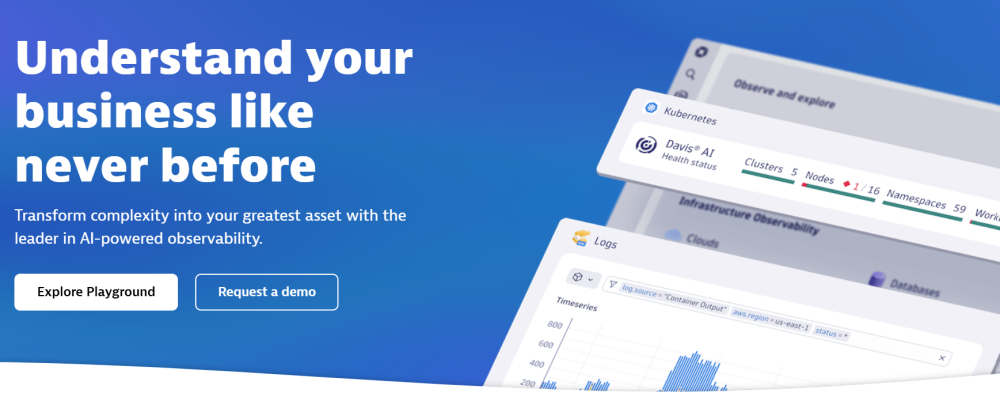
Known for:
Dynatrace is an enterprise-grade observability platform known for its AI-powered root cause analysis, automated instrumentation, and real-time dependency mapping. Its proprietary OneAgent and Davis AI engine enable deep, automatic monitoring across complex, large-scale environments, especially in Kubernetes, VM-heavy, or hybrid cloud ecosystems.
Key Features
• OneAgent Auto-Instrumentation
Dynatrace uses a single, auto-deploying agent (OneAgent) that automatically discovers services, dependencies, containers, and processes—eliminating the need for manual configuration or multiple agents.
• Davis AI & Smartscape Topology
Dynatrace’s Davis AI engine continuously correlates metrics, traces, logs, and events to deliver real-time root cause analysis. Smartscape builds an auto-updating service topology map, showing the flow and health of dependencies.
• Full MELT Observability
Includes native support for Metrics, Events, Logs, Traces, as well as infrastructure monitoring, APM, RUM, and synthetic testing—completing the MELT stack in a tightly integrated environment.
• Kubernetes & Cloud-Native Visibility
Optimized for Kubernetes, Dynatrace captures container-level metrics, pod health, cluster insights, and service interconnectivity without extra instrumentation.
• SLO Dashboards & Anomaly Alerts
Provides built-in dashboards for Service Level Objectives (SLOs), along with predictive anomaly alerts and problem impact scoring for incident prioritization.
Standout Features
- Fully automated discovery with no manual instrumentation
- Davis AI engine enables true root cause detection.
- Dynamic Smartscape topology mapping
- Integrated SLO dashboards and service impact scoring
- Deep Kubernetes observability out-of-the-box
Pros
- Highly automated monitoring reduces manual setup.
- Powerful AI for detecting performance anomalies
- End-to-end MELT stack in one platform
- Strong cloud-native and hybrid support
- Enterprise-grade support and scalability
Cons
- Limited OpenTelemetry flexibility—relies on OneAgent.
- High cost; usage-based pricing tied to host size and feature tiers
- Requires deeper onboarding to leverage advanced AI insights
- Self-hosted deployment is limited and complex.
- Smart sampling is AI-driven but not user-controlled
Best For:
Enterprises and platform teams managing high-scale microservice or hybrid infrastructures, who need automated discovery, AI-assisted observability, and tight SLO management, and have budget flexibility for a premium tool.
Pricing & Customer Reviews
- Pricing: $0.08/hour per 8 GiB host (~$57.60/month/host)
- Costs increase with SmartScape, log ingestion, and custom metrics
- G2 Rating: 4.5 / 5
Customers value Dynatrace’s automation and AI accuracy but report pricing complexity and a lack of transparency around usage tiers.
Dynatrace vs Coralogix
Dynatrace provides full-stack, AI-driven observability with automated discovery and intelligent problem correlation, whereas Coralogix offers manual routing flexibility focused on logs. Coralogix’s pricing is simpler, and log ingestion is cheaper, but it lacks Dynatrace’s deep topology mapping and SLO impact scoring. For teams prioritizing automation and AI insights, Dynatrace is superior; for those seeking manual log control and cost predictability, Coralogix holds an edge.
5. Splunk AppDynamics
Known for:
Splunk AppDynamics, now part of Cisco, is a traditional APM platform focused on transaction-level monitoring, code diagnostics, and business impact analysis. It’s widely used in large enterprises with monolithic or hybrid architectures where deep visibility into legacy stacks, database performance, and business KPIs is critical.
Key Features
• Business Transaction Monitoring
Splunk AppDynamics maps service flows into business transactions, helping teams trace user journeys and application performance back to revenue-impacting endpoints. This makes it useful for large applications with many interdependent layers.
• Code-Level Diagnostics
Offers deep code visibility with call graphs, SQL analysis, and method-level performance tracking for Java, .NET, PHP, and more—helping pinpoint bottlenecks in backend code and DB queries.
• Infrastructure & Database Visibility
Monitors infrastructure components and databases alongside applications, with insights into CPU, memory, thread states, and I/O wait times, offering full-stack diagnostics from frontend to DB layer.
• Real User Monitoring (RUM) & Synthetic Testing
Supports browser-based RUM and synthetic transactions to track user behavior and simulate performance in different regions or device types.
• Cisco Integration
Integrates with Cisco SecureX and network monitoring tools, offering an observability-plus-security lens for teams operating in hybrid IT or enterprise networks.
Standout Features
- Business-first transaction tracking
- Deep backend diagnostics at code and DB levels
- Integration with Cisco’s security and infrastructure stack
- On-prem deployment support for high-security environments
- Tailored for enterprise-scale legacy or hybrid applications
Pros
- Mature platform trusted by Fortune 500 companies
- Robust APM and root cause correlation
- Comprehensive infrastructure and database insights
- Powerful SLA/SLO-based reporting and dashboards
- Available as self-hosted or SaaS
Cons
- No native OpenTelemetry support; uses its agent.
- Limited flexibility for cloud-native or microservices
- No smart sampling or modern trace prioritization
- High learning curve and complex setup
- Enterprise pricing model lacks transparency.
Best For:
Large enterprises with legacy systems, monolithic architectures, or strict security environments, where business transaction mapping and full-stack correlation are more critical than OTEL-native or modular flexibility.
Pricing & Customer Reviews
- Pricing: Starts at ~$75/host/month, billed annually
- Requires separate licensing for infrastructure, DB, and synthetic features
- G2 Rating: 4.3 / 5
Users appreciate Splunk AppDynamics’ deep backend diagnostics, but note its complex setup, closed telemetry model, and cost inflexibility compared to newer platforms.
Splunk AppDynamics vs Coralogix
Splunk AppDynamics excels in code-level diagnostics, transaction mapping, and enterprise-grade APM across legacy systems, whereas Coralogix is built for log-centric, modern cloud pipelines. Splunk AppDynamics lacks OpenTelemetry compatibility and tail-based sampling, while Coralogix offers more control over log indexing and storage paths. If you’re managing large-scale monoliths with strict SLA enforcement, Splunk AppDynamics is stronger. For cloud-native, OTEL-driven teams seeking flexible log observability, Coralogix is more agile.
6. Sentry
Known for:
Sentry is a developer-focused platform built for real-time error monitoring, exception tracking, and lightweight performance profiling across frontend and backend applications. Its tight integration with source code, Git workflows, and alerting tools makes it especially popular among product engineering teams and JavaScript-heavy applications.
Key Features
• Real-Time Error Monitoring
Sentry tracks unhandled exceptions and performance issues across web, mobile, and backend services. It provides rich context like stack traces, breadcrumbs, release version, and user impact, making it easy to debug quickly.
• Performance Monitoring
Includes basic distributed tracing and route-level performance tracking. Helps teams detect slow transactions, API bottlenecks, and N+1 query patterns—primarily for web and frontend-centric apps.
• Wide SDK Coverage
Sentry supports a wide array of SDKs: JavaScript, React, Node.js, Python, Go, PHP, iOS, Android, and more. It’s designed for quick integration with full-stack applications.
• Issue Grouping & GitHub Integration
Automatically groups errors by cause and integrates with GitHub, Jira, Slack, Microsoft Teams, and more—allowing devs to triage, fix, and track errors without context switching.
• Self-Hosted Option
Sentry offers a Docker-based OSS version, which teams can self-host for privacy or compliance reasons—rare among SaaS-first observability tools.
Standout Features
- Developer-first UI with full stack trace context
- Strong support for frontend frameworks and mobile SDKs
- Git-based source mapping and release tracking
- Easy setup and high usability for dev teams
- OSS self-hosting is available for private environments
Pros
- Great for debugging and fast error resolution
- Lightweight and fast to set up
- Excellent integration with engineering workflows
- Self-hosted option offers flexibility.
- Strong mobile and browser SDK support
Cons
- Not a full APM—lacks infra metrics, logs, and deep backend tracing
- No support for synthetic monitoring or Kubernetes observability
- No OpenTelemetry support; uses proprietary SDKs
- Head-based sampling only—may drop high-value traces under load.
- Difficult to scale for full-stack or infra observability needs
Best For:
Frontend and full-stack product teams that prioritize fast debugging, error resolution, and release monitoring. Ideal for applications with high frontend visibility and CI/CD workflows but not infrastructure-heavy workloads.
Pricing & Customer Reviews
- Free tier available for small teams
- Paid tiers start at $26/month (Team) and $80/month (Business)
- Self-hosting supported via Docker
- G2 Rating: 4.5 / 5
Users love Sentry’s developer UX, fast setup, and debugging depth, but often mention its limited backend observability and lack of broader MELT coverage.
Sentry vs Coralogix
Sentry focuses on frontend and application-level errors, while Coralogix is centred on log routing and backend telemetry ingestion. Sentry doesn’t support OpenTelemetry, log processing, or infra observability, making it insufficient as a full observability solution. Coralogix offers more flexible data control but lacks Sentry’s rich error debugging and UI for devs. Teams wanting full-stack observability with infrastructure, logs, and metrics will outgrow Sentry faster than Coralogix.
6. New Relic
Known for:
New Relic is a veteran in the observability space, best known for its full-stack APM capabilities, custom dashboards, and wide visibility into application and infrastructure performance. It’s used by DevOps and SRE teams to monitor distributed applications and microservices across frontend, backend, and infrastructure layers, though concerns around pricing, agent lock-in, and flexibility have led many teams to seek alternatives.
Key Features
• Full-Stack Observability
New Relic offers an integrated UI for APM, RUM, Logs, Infrastructure, Errors, and Synthetic Monitoring, with custom dashboards powered by NRQL (New Relic Query Language).
• Distributed Tracing
Supports trace-based diagnostics and includes trace maps, span-level insights, and an Errors Inbox for correlating exceptions with specific services. However, it uses head-based sampling (~10 traces/min), which can miss slow/error traces under traffic.
• Real User & Synthetic Monitoring
Enables browser session monitoring (RUM) and synthetic tests across geographies to detect frontend latency, downtime, or regressions.
• Custom Dashboards with NRQL
Teams can query telemetry using NRQL and build tailored dashboards for KPIs, SLOs, and alerting.
• Pre-Built Cloud Integrations
Includes integrations for AWS, Azure, GCP, Kubernetes, and more—but many advanced features are only available in higher-priced tiers.
Standout Features
- Robust NRQL dashboarding and visualization engine
- Consolidated telemetry from infra to user-level
- Wide cloud provider and service integration catalog
- Synthetic and browser monitoring out-of-the-box
- Mature enterprise support infrastructure
Pros
- Unified observability across the MELT stack
- Well-established ecosystem and documentation
- Built-in alerts and SLO dashboards
- Strong synthetic monitoring and browser RUM
- Prebuilt visualizations and integrations for quick start
Cons
- Cloud-only – no support for self-hosting or private deployments
- High cost for full access (~$400/user/month for enterprise tiers)
- Limited OpenTelemetry and Prometheus support; favors proprietary agents
- Head-based sampling leads to low-fidelity traces under high volume.
- Slower support and longer onboarding for complex environments
Best For:
Large DevOps or platform teams needing complete full-stack visibility and dashboard flexibility in cloud-first environments, and that can absorb higher per-user and data ingestion costs.
Pricing & Customer Reviews
- Pricing: $0.30–$0.35/GB data ingestion + up to $400/user/month
- Additional charges for retention, synthetics, and advanced dashboards
- G2 Rating: 4.3 / 5
Users praise New Relic’s visualization and full-stack coverage but consistently criticise the complex pricing, lack of deployment flexibility, and agent lock-in.
New Relic vs Coralogix
New Relic provides broad MELT support and strong dashboarding, whereas Coralogix focuses on log routing and ingestion efficiency. However, New Relic lacks self-hosting, smart sampling, and cost predictability—areas where Coralogix excels. While New Relic offers more visibility across frontend/backend, Coralogix gives better log control and routing customization. For cloud-native teams needing OpenTelemetry and compliance flexibility, both tools present gaps.
Conclusion: Choosing the Right Coralogix Alternative
As observability requirements expand beyond log routing into full MELT (Metrics, Events, Logs, Traces) visibility, many teams are finding Coralogix’s log-centric model insufficient for modern, distributed systems. While it offers powerful log control and cost-saving mechanisms like Streama™, its limited support for full-stack monitoring, lack of smart sampling, and cloud-only data flow raise challenges in compliance, cost predictability, and operational scalability.
The right alternative should deliver:
- Unified observability across metrics, traces, logs, RUM, and synthetics
- Native OpenTelemetry support for vendor-neutral instrumentation
- Smart sampling to lower data ingestion costs without losing insights
- Self-hosting options to meet regulatory and data residency requirements
- Transparent pricing models that scale predictably with usage
CubeAPM emerges as the most balanced Coralogix alternative—offering full MELT coverage, smart trace sampling, OTEL-native compatibility, and flat, usage-based pricing at $0.15/GB. With real-time support and flexible deployment models, CubeAPM empowers engineering teams to scale observability confidently—without the complexity or cost surprises of legacy and log-first platforms.

